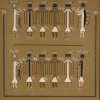secret societies
Every Southwestern Pueblo society has slightly different ceremonial practices, yet each Pueblo maintains a variety of priesthoods that perform ceremonies in kivas and plazas. These priesthoods are also known as secret or kiva societies. Each society has a different obligation it fulfills for the benefit of the Pueblo at large, including farming, healing, and even warrior duties. Boys between the ages of five to fourteen, depending on the Pueblo, are initiated into a society, and members of the kiva societies act as their sponsors as they learn the duties, rites, dances, and ceremonials associated with their kiva.









